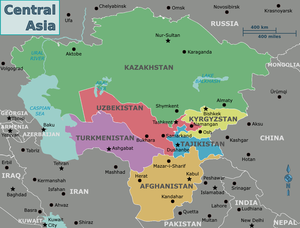
The history of Central Asia concerns the history of the various peoples that have inhabited Central Asia. The lifestyle of such people has been determined primarily by the area's climate and geography. The aridity of the region makes agriculture difficult and distance from the sea cut it off from much trade. Thus, few major cities developed in the region. Nomadic horse peoples of the steppe dominated the area for millennia.
Relations between the steppe nomads and the settled people in and around Central Asia were marked by conflict. The nomadic lifestyle was well suited to warfare, and the steppe horse riders became some of the most militarily potent people in the world, due to the devastating techniques and ability of their horse archers.[1] Periodically, tribal leaders or changing conditions would cause several tribes to organize themselves into a single military force, which would then often launch campaigns of conquest, especially into more 'civilized' areas. A few of these types of tribal coalitions included the Huns' invasion of Europe, various Turkic migrations into Transoxiana and most notably the Mongol conquest of much of Eurasia.
The dominance of the nomads ended in the 16th century as firearms allowed settled people to gain control of the region. The Russian Empire, the Qing dynasty of China, and other powers expanded into the area and seized the bulk of Central Asia by the end of the 19th century. After the Russian Revolution of 1917, the Soviet Union incorporated most of Central Asia; only Mongolia and Afghanistan remained nominally independent, although Mongolia existed as a Soviet satellite state and Soviet troops invaded Afghanistan in the late 20th century. The Soviet areas of Central Asia saw much industrialization and construction of infrastructure, but also the suppression of local cultures and a lasting legacy of ethnic tensions and environmental problems.
With the collapse of the Soviet Union in 1991, five Central Asian countries gained independence — Kazakhstan, Uzbekistan, Turkmenistan, Kyrgyzstan, and Tajikistan. In all of the new states, former Communist Party officials retained power as local strongmen, with the partial exception of Kyrgyzstan which, despite ousting three post-Soviet presidents in popular uprisings, has as yet been unable to consolidate a stable democracy.[2]